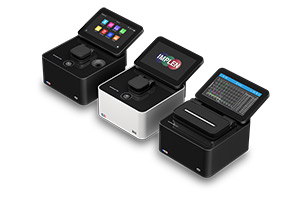Detection of Adulterants In Morphine Sulfate Solutions Using UV/Vis NanoPhotometer® Instrumentation
NanoPhotometer® Application Notes
Katherine A. Roberts, PhD and Thomas Sahiri, PhD
Implen GmbH, Munich, Germany
Abstract
A growing problem among California’s Emergency Medical Services is the theft of morphine from vials that are stored in their emergency vehicles and substituting the morphine with saline or other solutions. This study focuses on this specific problem. The objective was to develop and test a simple, rapid, reliable and reproducible procedure to detect whether a morphine sulfate solution has been adulterated.
The research was restricted to diluting a 4 mg/ml dose of morphine sulfate contained in a carpuject cartridge. The following four solutions were used to dilute morphine sulfate: nanopure water, saline, diphenylamine, and epinephrine. The effect of diluting morphine sulfate with each of the solutions was measured by UV/VIS spectrophotometry using an Implen NanoPhotometer®. Ten replicate measurements of the absorbance values were obtained for five concentrations of each adulterated morphine solution to determine the mean absorbance values.
Introduction
The literature on the subject of drug tampering activity (scholarly or otherwise) is limited to a few articles, a book and a number of newspaper reports. The limited literature concerns the restricted areas where the tampering activity takes place. In hospitals, access to controlled substances is secured and available only to authorized professionals, some of whom take advantage of their privileges to tamper with drugs away from peer oversight and public scrutiny. The tampering of drugs aboard a medical emergency vehicle is even more difficult to detect. The vehicles are constructed to block public view from the interior area where patients are treated and transported. Thus, only two operators have immediate and continual access to morphine and potential drug diluents.
These individuals often form a close camaraderie and become bound by a mutual code of silence in an environment that is highly conducive to tampering. An overwhelming number of tampering cases go undetected, unreported and unexamined, with press accounts surfacing only when they bear serious consequences.
Purpose of Study
The study was designed to create a rapid, reproducible, reliable, robust and ostensibly cost-effective analytical approach to detect cases of tampered morphine.
A NanoPhotometer® instrument (Implen, Inc.) was evaluated to determine if it meets these criteria. The analysis focused on adulterating morphine sulfate solutions with various substances/pharmaceuticals commonly available to emergency medical technicians. Serial dilutions of morphine sulfate were also prepared with each adulterant to simulate tampering. A UV/VIS NanoPhotometer® instrument was evaluated as a potentially viable technique to detect the presence of an adulterant in morphine sulfate.
Materials and Methods
The pharmaceuticals were supplied to CSULA by the Ventura County Emergency Medical Service Agency in conjunction with the County Pharmacy Administration of Los Angeles. This study was limited to the following pharmaceuticals that are currently available on mobile emergency vehicles and limited to the following: 4 mg/ml morphine sulfate and 0.9% Sodium Chloride Injection (Hospira); 50 mg/ml diphenhydramine (Baxter Healthcare); 2.5 mg/ml epinephrine (manufacturer unknown). In addition, physiological saline (0.9%)and nanopure water were used as diluents. A 2 μl sample volume was used for each analysis and all samples were analyzed in replicates of 10.
Conclusions
With respect to the adulterants evaluated, the findings support that the Implen NanoPhotometer® instrument provides an affordable, sensitive, reliable and portable screening test to detect tampered morphine.
Adulterated morphine was detected based on either qualitative (diphenylamine) or quantitative (saline, nanopure water, and epinephrine) differences observed in the UV spectra.
A linear relationship was established between the mean morphine concentration of morphine and the corresponding absorbance, in accordance with Beer’s law. It was determined that the saline, nanopure water and epinephrine adulterants did not interfere with absorbance of morphine at 269 nm, as observed by the linear relationship between the concentration of morphine and the corresponding absorbance value. R-square, as a coefficient of determination, consistently indicated a clear positive correlation among measured values.
Please Click Here to View Graphs Described in This Application Note
Select References
Cheung J, Chong S, Kitrenos J, & Fung H. (1991).
Use of refractometers to detect controlled-substance tampering.
American Journal of Hospital Pharmacists, 48, 1488-92
Gill D, Goodwin S, Knudsen A, & Wade C. (1990).
Refractometer screening of controlled substances in an operating room satellite pharmacy.
American Journal of Hospital Pharmacists, 47, 817-18.
O’Neal B, Bass K, & Siegel J. (2007). Prevention of controlled substance diversion-scope, strategy, and tactics.
Hospital Pharmacy, 42, 359-67.





